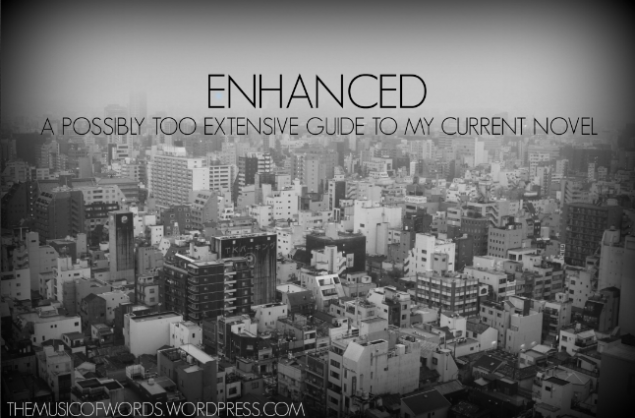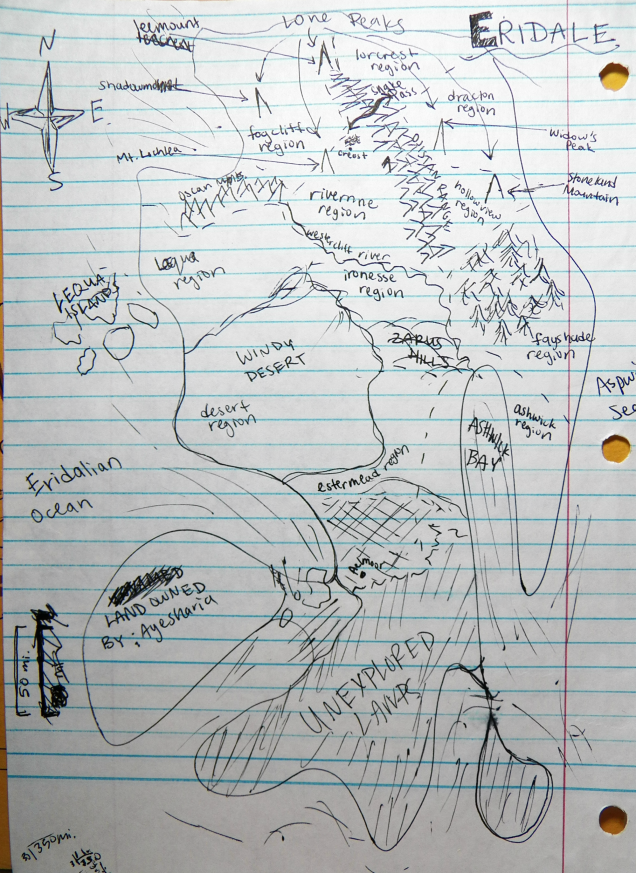
I’m beginning a field guide to help you identify characters, places, and plots in my current novel, Enhanced (and in the entire series), including fun facts and more info than you ever wanted to know! It’ll be great, just trust me.
Plus, once I’m done posting all three parts (Places, Characters, and Plots (and maybe Other?)), I’m going to compile them into one huge field guide that can be found under the “Epic Sci-Fi” menu. That way, if you ever have no idea what I’m referencing in one of my posts, you can check out the field guide! Am I too excited about this? …Probably.
PLACES
THE CITY

The city that as of yet is still nameless is the central location of the novel. In the city, it’s like our life–but cooler, with interesting technology like 3-D computers and airtrains and awesomeness like that. It’s full of rich people who are busy and wrapped up in their own lives. It also rains all the time, but that happens in the Outer Regions (see Places–The Outer Regions) as well.
Fun fact: the city was inspired by my trip to NYC, so if you’ve ever been there, that’s kind of what it’s like. But cooler.
THE ENHANCEMENT FACILITY (also referred to as THE FACILITY)
This is a government-owned facility where genetic modifications (“Enhancements”) are done on people in the name of science and healing. If you were clever, you probably noticed the correlation between “Enhancement Facility” and the title of “Enhanced.” If you didn’t notice, that’s okay too. That’s because the main characters believe it’s a horrible place and want to break in and rescue some people (see Plots–Rescue Seth). Namely, a guy named Seth (see Characters–Seth).
Fun Fact: Throughout the book, six of the major characters spend some time in the Facility. By the end of Cryonic, all of the major characters except for two will have gone there. (And, trust me, there’s a lot of major characters.)
THE DELOREM PROGRAM (also referred to as THE DELOREMS or THE REMS)
The Delorem Program is another government-owned…thing. *headdesk* There, people are paid to experience pain. It’s basically a last resort for those who are poor in the Outer Regions (see Places–The Outer Regions) to support their families. Because of the desensitization to pain, it’s rumored that the people in the program (the “Delorems”) can’t feel any emotions.
Fun Fact: “Delorem,” in Latin, means pain. So, “The Delorem Program” literally means “The Pain Program.” Sounds happy, right?
THE SAFEHOUSE
The safehouse is where the Reapers (see Characters–The Reapers) hang out and basically do their criminal stuff without being caught by the authorities. Because there’s so little ground space in the city, the house itself is small, but the basement is large and stocked full of all sorts of stuff.
THE OUTER REGIONS (also referred to as THE REGIONS)
The Outer Regions is the area that surrounds the city (see Places–The City) and is full of lots of poor people (extremely third world conditions) under governmental control. However, because they don’t know any better, most of them love the government (see Characters–The Pinnacles). And, of course, the people in the city think that the people in the Outer Regions are savages. There are eight regions and each has a specific purpose in supplying and supporting the city.
Fun Fact: The Outer Regions actually have their own religion, called Cajinism. It comes to play in Cryonic, the second book in the series, with Kai and Brie. (see Characters–Kai and Characters–Brie).
REGIONS ONE AND SIX
Region One and Region Six are both variable regions, which basically means they are well-rounded and end up doing whatever the pinnacles tell them to (see Characters–The Pinnacles). *nods*
REGIONS TWO, THREE, FOUR, AND FIVE
Regions Two through Five are all related to farming stuff. Because, hey, somebody’s got to feed everyone, right? Region Two specializes in herbs and plants grown in greenhouses, Region Three does livestock, Region Four grows orchards, and Region Five is centered around farming (as in growing plants and harvesting them).
Brie and Seth are from Region Four, and Kai is from Region Five (see Characters–Brie, Characters–Seth, and Characters–Kai).
REGIONS SEVEN AND EIGHT
Region Seven and Region Eight both use metal-work. Because of this, they have to use more complicated machines are are less of a third-world place and a little more suspicious of the city and the pinnacles. Region Seven does the large metal work and Region Eight does the fine metal work.
Taira and Will are from Region Eight (see Characters–Taira and Characters–Will).
And…yeah, I think that’s it for this section. Yup, Places is definitely the shortest (and possibly the most boring) of all of them. However, the places in the city are rather essential in order understand the other ones.
How did you like the post? Are you excited or not for the other sections? Are all of the “see this” parentheses annoying? They were meant as a joke, and then I think they just got tedious by the end, so should I take them out of the other two sections? Any tips for how to make the next section better or improve this one? Are you excited about this novel?
And ju st because you are awesome for reading this all, have a sneak peek at one of the characters’ hairstyles. For bonus points, be the first to guess which character it is!
st because you are awesome for reading this all, have a sneak peek at one of the characters’ hairstyles. For bonus points, be the first to guess which character it is!
 Yes, Camp NaNoWriMo has started! The excitement will wear off in a week or two, I know, but right now I’m excited about Camp and life and everything. Plus, I get Spring Break off of school next week, and it is fantastic how it coincides with the first week of Camp. That way I’ll have time to write while I actually want to.
Yes, Camp NaNoWriMo has started! The excitement will wear off in a week or two, I know, but right now I’m excited about Camp and life and everything. Plus, I get Spring Break off of school next week, and it is fantastic how it coincides with the first week of Camp. That way I’ll have time to write while I actually want to.






